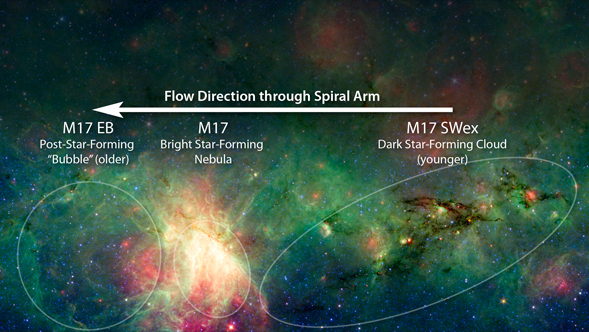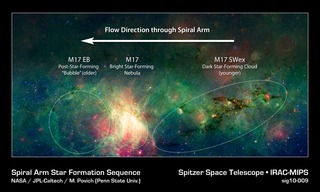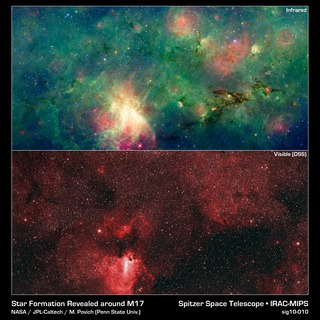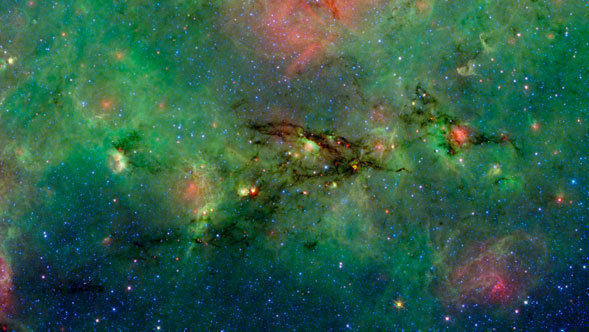
News Release • July 7th, 2010 • feature10-09 •
By Adam Hadhazy
NASA's Spitzer Space Telescope has revealed a cosmic cloud shaped like a flying dragon that has a secret burning behind its dark scales.
Though appearances deceive, stars are forming in this cloud about as fast as in a neighboring, dazzling nebula illuminated by giant stars. But no similar stellar behemoths have yet emerged to set the dragon's dusty innards aglow.
"We believe we've managed to observe this cloud in a very early phase of star formation before its most massive stars have ignited," says Matt Povich, an astronomer at Penn State and lead author of a study published April 21 in The Astrophysical Journal Letters.
This strange starry absence in the dark cloud, dubbed M17 SWex, speaks to the mysteries surrounding the birth of the heftiest stars in the universe.
Perhaps these rare, massive stars form after typical stars do, or when these smaller cousins infrequently collide - or maybe an outside "trigger" of some sort is needed. To wit, a wave of massive star formation, possibly caused by the crossing of a grand spiral arm of the Milky Way galaxy, appears to be rippling through M17 SWex's entire region.
This surge, however, has not yet reached the beastly cloud, establishing M17 SWex as a compelling place to explore the origin of giant stars. "This flying dragon of M17 SWex might carry with it important clues about how massive stars ever come into being," says paper co-author Barbara Whitney, a Senior Research Scientist at the Space Science Institute in Boulder, Colorado.
The Dragon's Heart of Darkness
From "tail" to "snout," M17 SWex stretches about 160 light years. Though astronomers first discovered this shadowy monster in the constellation of Sagittarius more than 30 years ago, it took the keenness of Spitzer's instruments to spot the hidden stellar nursery within.
To the lower left of M17 SWex in this image blazes M17, an ultra-bright nebula catalogued by the French astronomer Charles Messier in June 1764. This resplendence is also called the Omega or Swan Nebula for how it looks in the optical light we see. Spitzer's infrared vision has shown that M17 and M17 SWex, besides being amongst the closest to us, are also some of the busiest star-making factories in the Milky Way.
The data for the new study on M17 SWex and its neighborhood come from the Spitzer Galactic Legacy Infrared Mid-Plane Survey Extraordinaire (GLIMPSE), completed in 2007, and the Multi-band Imaging Photometer for Spitzer Galactic Plane Survey (MIPSGAL) that finished observations in 2008.
Within these cosmic fields, Spitzer detected the infrared light given off by heated dust in M17 SWex signifying 488 newly forming stars. A quarter of this brood consists of dusty shells warming as gravity pulls more gas into their budding central stars. The majority, though, have grown disks of material around their middles that may give rise to planets.
These fledgling stars follow and are fueled by the dust filaments comprising the head, narrow body and flapping wings of their dragon-like host cloud. More than 200 of these younglings will become class B stars, larger and toastier than our Sun with a blue-white color. Some of the biggest have already lit up a blob of dusty, hydrogen gas into a demonic, red dragon's eye.
Conspicuously absent from M17 SWex, however, are class O stars - the bluest, hottest and biggest of new stars. Though relatively rare in the cosmos, O stars are what light up neighboring M17, and given all the star-forming material in M17 SWex, these bright beauties should be on the scene there as well.
O Stars, Where Art Thou?
One possible answer to this riddle is that developing O stars - wild, windy and spewing radiation - rapidly destroy their dusty envelopes that Spitzer would otherwise sniff out. But these blazingly blue behemoths would light up everything in M17 SWex, says Povich, making detection easy. More likely explanations are that colossal stars form later, perhaps needing an extra impetus to nudge them into existence.
This solution for the missing O stars hints at a larger, cosmic "domino effect" that might be happening in the general M17 region, in which a shock wave from a burst of star birth sets off a chain of sequential massive star formation.
In support of this idea, Povich and his colleagues recently noticed a giant "bubble" in the far left of the image blown by blue O stars aged some two to five million years. Part of this great smoke ring appears to shape the left, curving border of the M17 nebula, whose interior is enflamed by a star cluster about one million years old. Farther to the right, the shrouded, budding stars in M17 SWex have not yet celebrated their one millionth birthdays - truly infants in the stellar sense.
The architecture of the Milky Way galaxy likely plays a role in this chronology. In its orbit around the Milky Way's center, the M17 region is now passing though the Sagittarius spiral arm, one of the giant bands of stars and gas pinwheel out from our galaxy's hub. The greater concentration of gas and dust in the arm is mashing material together in the M17 region, triggering a round of massive star formation that could then propel more star births on down the line.
"The time-sequence of star formation proceeds in the same direction that a spiral arm crosses the M17 cloud complex," Povich says. "The M17 region brings to mind images of other spiral galaxies where the leading edges of the arms appear blue with young O stars but the trailing edges are still dark with obscuring dust like in M17 SWex."
For the M17 region to pass through the edge of the Sagittarius spiral arm should take about a million years - a figure consistent with the age spread amongst the cloud complex's major features.
Further investigation of the M17 SWex flying dragon and other clouds may reveal whether massive stars need this added oomph of an expanding shock wave to come to luminous life.
"We hope people will use M17 SWex as a new laboratory for studying this exact problem of how massive star formation happens," says Povich. "Most very young clouds being studied don't have as much going on as this one does."







